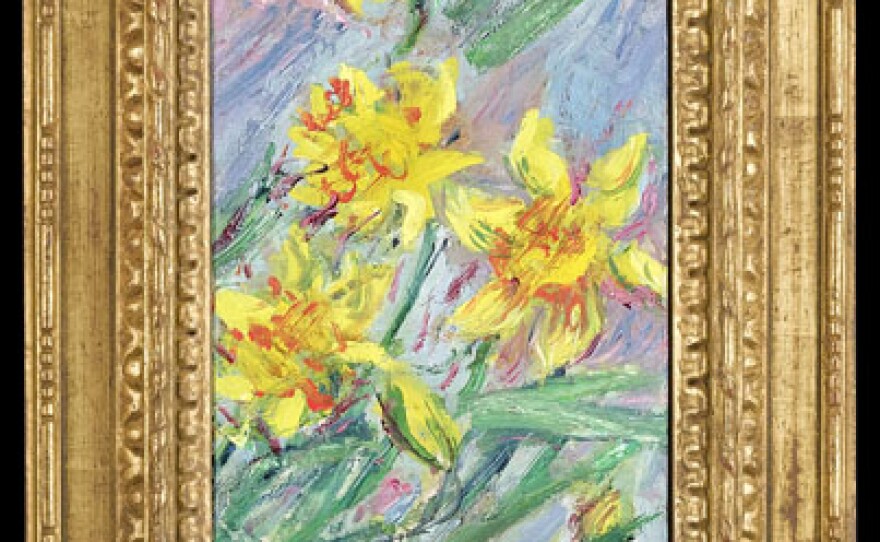Amid the bustle of the French Quarter are some rooms well back from the street that are adorned with 40 Impressionist paintings. While some are for sale, all are free to behold.
Bill Rau’s family has operated their antique store on Royal Street for 100 years. They decided to mark the occasion with a look back at what was most popular when it first opened. A century ago, Impressionism was all the rage.
“It’s certainly the most famous that we deal in, but it’s also something that we love, and because we’ve been in business for so long that we also knew where a lot of great pieces were,” said Rau. “We couldn’t have an exhibition of Raphael pieces because we could never get those. But certainly Impressionism, we knew where a lot of the bodies were buried.”
As he walked through the show gallery tucked in back of the shop, just past the knight in shining armor, Rau described some of the paintings on display and what makes them so special. One is an early still-life by Paul Gauguin.
“It’s a blue vase, a wonderful blue vase. And the blue is interesting. It brings back the Renaissance, because during the Renaissance to make blue they would actually take pure lapis and grind it up, and this is one of those few vases — one of the few blues — you’ll ever see done after the Renaissance that has that same feel to it,” Rau said. Gauguin consciously worked to make it in a classical vein, according to Rau, “And it’s on a book of music and the most beautiful flowers out of there, and it’s signed by Gauguin and it’s quite early. It’s 1874. So it’s really in a great period of his, and it’s just a beautiful, extraordinarily rare work of art.”
And the price tag? $4.8 million.
A painting featured on a 19th century European art book published by Rau is not done by one of the well-known stars, but its style and use of light is unmistakable as Impressionist. It’s called “Woman in a Canoe” from 1876 by Giuseppe DeNittis, and is owned by a New Orleans collector.
“There’s very few paintings that have it all,” Rau said. “It’s a wonderful lady going down what we could call a bayou, but a stream, in a beautiful white flowing silk dress with her parasol keeping her in the shade in a canoe. And it’s just stunning. There’s a whole bunch of things to make it wonderful.
“This is a hard one to classify,” he continued. “It’s definitely an Impressionist painting, but there was a period of painting called Belle Époque. What that means was really was showing the glories and greatness of France. And these beautifully dressed women, so she’s very Belle Époque: the parasol and the back of light’s coming through and it just glows. It’s one of those paintings that when you look at it you stop and go ‘That is a true work of art.’ It’s as fine as any painting you’ll ever see anywhere in the world, in any museum.”
Nearby is one small painting, about 17-by-6 inches across. The name, however, is big. Claude Monet. And he painted it for a room in his art dealer’s home.
“Monet put a lot of effort and painting panels on this most beautiful room,” said Rau. “We have pictures of the room. Unfortunately the room was disassembled in the 1930s. But all the panels match, and he did these wonderful daffodil flowers, and in beautiful yellows and greens with blue backgrounds and pinks and just something that’s extraordinary.”
Standing near Rau as he was describing some of the show’s paintings was Lisa Rotondo-McCord. She’s curator of Asian art at the New Orleans Museum of Art. She stopped by to see works by Impressionists who were influenced by Japanese art.
“Monet had over 200 Japanese prints in his collection in his living room in Giverny,” said Rotondo-McCord.
She explains how a European movement was influenced by Asia. It began when Japanese art was featured at the Paris World’s Fair of 1867. And she says the Monet at Rau is an example.
“’Daffodils’ — which I realize is made for a dining room and was a panel, part of a larger room. But it’s also the format of scroll painting for Japan. This is a typical proportion for Japanese scrolls. It’s very, in this case, smaller than a lot of scrolls, and it’s also just the flowers against a flat background, which, again, we know that he owned prints that showed the same kind of principles.”
Another European painter is featured in the final part of the show. It demonstrates how Impressionist techniques were adapted into the post-Impressionist and other later movements. That painter?
“He’s most famous not because he was a painter but because he was one of the most famous people of all times. And it was painted by Sir Winston Churchill,” said Rau.
It’s Churchill’s depiction of a Roman aqueduct in the south of France. Painting became one of Churchill’s favorite pastimes. His work is featured at the show alongside masters of the era.
The show is open to the public through January 4 – Monday through Saturday.
M.S. Rau Antiques
630 Royal Street, New Orleans
(504) 523-5660







